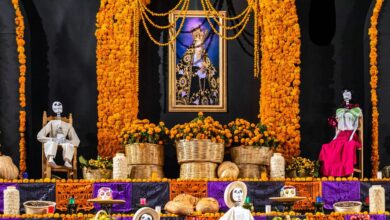Easter — and its decorative eggs, delicious hams, and cheerful baskets — are coming up sooner than you think. The Christian holiday will fall on April 4 this year. While the central story may sound familiar, there’s a lot left to learn about the unique traditions surrounding this special Sunday. Between the cute bunny rabbits and copious amounts of chocolate, the celebration has evolved over the years with a whole host of customs both new and old.
Before you sit down for a delicious brunch or entertain the kids with some Easter crafts, take a moment to learn about this holiday’s rich background, including its special foods, superstitions, and symbols. Then impress your family and friends with a little Easter trivia that explains the little-known origins behind your favorite traditions.
1
Easter baskets have special symbolism.
2
There’s a reason you probably eat ham for Easter dinner.
Historically, most early Easter celebrants would have eaten lamb for this special occasion as the holiday has its roots in Jewish Passover. Most American Easter dinners now feature ham, however, because of the timing of the holiday. Years ago, hams cured over the winter months would have been ready to serve in the early spring.
3
Easter lilies are a relatively new tradition.
These beautiful blooms first originated in Japan and later arrived in England in the late 18th century. The U.S. only caught onto the trend after World War I. The transition from dormant bulbs to delicate flowers brings to mind hope and rebirth, two important themes of the day.
4
Easter eggs had a medieval twist.
Think Easter egg hunts are odd? Listen to this medieval game children’s game: The priest would give one of the choir boys a hard boiled egg, and the boys would pass it amongst themselves until the clock struck midnight, when whoever was holding it then got to eat it. Sounds … fun?
5
Easter clothes used to be considered good luck.
Old superstition held that if you wore new clothes on Easter, you would have good luck for the rest of the year. In fact, it was so widely believed that upper-class New Yorkers would quite literally strut their stuff coming out of mass in beautiful and well-to-do Fifth Avenue churches. This tradition become the basis of the modern, and decidedly less elitist, Easter Parade and Easter Bonnet Festival in New York.
6
Easter eggs date back way before Easter.
7
The holiday was named after the Anglo-Saxon goddess Eostre.
Scholars believe that Easter was named after a festival celebrating Eostre and the coming of spring. Her sacred symbols are thought to have been the hare and the egg.
8
Eggs are dyed to represent the blood of Jesus Christ.
9
Good Friday is recognized as a holiday in only 12 states.
10
In 2020, 77% of American adults celebrated the holiday.
About half of those chose to mark the occasion with holiday meal, and a third decided to visit family and friends virtually, according to the National Retail Federation.
11
We can thank Germany for the bunny.
The idea of the Easter bunny giving candies and eggs is said to have originated in Germany during the Middle Ages, with the first written mention of this tradition dating back to the 16th century. Dutch settlers in Pennsylvania brought the bunny to the United States in the 1700s.
RELATED: 25+ Adorable Springtime Cupcakes for Easter
12
Easter and Halloween often compete for the highest candy sales every year.
13
Americans eat about 1.5 million Peeps during Easter.
That makes these colorful marshmallows the most popular non-chocolate Easter candy. The Bethlehem, Pennsylvania, factory makes an impressive 5.5 million a day.
14
In 1953, it took 27 hours to make one Peep.
That’s back when they were still new to the world and were handmade with a pastry tube. But don’t worry, it was sped up to six minutes thanks to a unique machine called The Depositor.
15
More than 1.5 Million Cadbury Creme Eggs are made every day.
16
Americans consume more than 16 million jelly beans during Easter.
That’s enough jelly beans to circle the globe not once, not twice, but three times — or to fill a plastic egg the size of a nine-story building. First introduced as an Easter treat in the 1930s, we can’t imagine this day without them.
17
Around 90 million chocolate bunnies are sold for Easter.
18
A surprising 59% of people eat the ears first.
Only a handful start with the feet or tail, and the rest apparently don’t have a plan of action.
19
The White House Easter Egg Roll tradition started in 1878.
20
In the old days, pretzels were associated with Easter.
Why? Because the twists of this salty treat resemble arms crossing in prayer. We say it’s time to bring back this savory snack to the sweets-filled holiday.
This content is created and maintained by a third party, and imported onto this page to help users provide their email addresses. You may be able to find more information about this and similar content at piano.io
Source link







